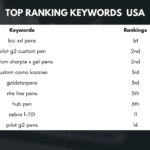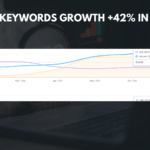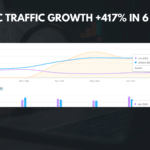
|
Getting your Trinity Audio player ready... |
In today’s digital age, having a strong online presence is crucial for businesses of all sizes. With the majority of consumers turning to the internet to research products and services before making a purchase, it is essential for businesses to establish a strong online presence in order to reach their target audience and stay competitive in the market.
Statistics show just how important online presence is for businesses. According to a study by Retail Dive, 87% of shoppers begin their product search online. Additionally, 93% of online experiences begin with a search engine, as reported by Search Engine Journal. These statistics highlight the fact that if your business does not have a strong online presence, you are missing out on potential customers and revenue.
Key Takeaways
- Having a strong online presence is crucial for businesses to succeed in today’s digital age.
- Understanding the basics of SEO is essential for improving your website’s visibility on search engines.
- Creating a search engine friendly website involves optimizing your content, using relevant keywords, and having a user-friendly design.
- Building a strong social media presence involves creating engaging content, interacting with followers, and utilizing social media advertising.
- Utilizing online directories and listings can help improve your local SEO and increase your visibility to potential customers.
Understanding the Basics of Search Engine Optimization (SEO)
Search Engine Optimization (SEO) is the process of optimizing your website and its content in order to improve its visibility in search engine results pages (SERPs). When a user searches for a particular keyword or phrase, search engines like Google use complex algorithms to determine which websites are most relevant and should be displayed at the top of the results.
To understand SEO, it is important to understand how search engines work. Search engines use web crawlers, also known as spiders or bots, to crawl and index websites. These crawlers analyze various factors such as website structure, content relevance, and user experience to determine how well a website should rank in search results.
Keyword research is a crucial aspect of SEO. By identifying the keywords and phrases that your target audience is using to search for products or services related to your business, you can optimize your website and its content to rank higher in search results. This involves incorporating these keywords strategically into your website’s meta tags, headings, and content.
On-page optimization techniques involve optimizing various elements on your website itself, such as meta tags, headings, URLs, and image alt tags. Off-page optimization techniques, on the other hand, involve building backlinks to your website from other reputable websites. Both on-page and off-page optimization techniques are important for improving your website’s visibility in search results.
Creating a Website that is Search Engine Friendly
Having a website that is search engine friendly is essential for improving your online presence. A well-designed and structured website not only makes it easier for search engines to crawl and index your site, but it also provides a better user experience for your visitors.
When it comes to website design and structure, simplicity is key. A cluttered and confusing website can deter visitors and negatively impact your search engine rankings. Make sure your website has a clean and intuitive design, with clear navigation menus and easily accessible information.
Optimizing your website content is another important aspect of creating a search engine friendly website. Make sure your content is relevant, informative, and engaging. Incorporate your target keywords strategically throughout your content, but avoid keyword stuffing, as this can have a negative impact on your search engine rankings.
In today’s mobile-first world, it is also crucial to ensure that your website is mobile responsive. With the majority of internet users accessing websites on their mobile devices, having a mobile-friendly website is not only important for user experience but also for search engine rankings. Google has even implemented mobile-first indexing, which means that the mobile version of your website is now the primary version used for indexing and ranking.
Building a Strong Social Media Presence
| Metrics | Description |
|---|---|
| Number of Followers | The total number of people who follow your social media account. |
| Engagement Rate | The percentage of followers who interact with your content through likes, comments, shares, etc. |
| Reach | The number of unique users who see your content on social media. |
| Impressions | The total number of times your content is displayed on social media. |
| Click-Through Rate (CTR) | The percentage of users who click on a link in your social media post. |
| Conversion Rate | The percentage of users who complete a desired action, such as making a purchase or filling out a form, after clicking on a link in your social media post. |
| Brand Mentions | The number of times your brand is mentioned on social media, either by your followers or other users. |
| Sentiment Analysis | The analysis of the tone and emotion behind social media mentions of your brand, whether positive, negative, or neutral. |
Social media has become an integral part of our daily lives, and it presents a huge opportunity for businesses to connect with their target audience and build brand awareness. Having a strong social media presence can significantly improve your online visibility and help you reach a wider audience.
One of the benefits of social media for businesses is the ability to engage directly with your audience. By posting regular updates, responding to comments and messages, and sharing valuable content, you can build a loyal following and establish yourself as an authority in your industry.
When it comes to choosing the right social media platforms for your business, it is important to consider your target audience and the type of content you want to share. Different platforms have different demographics and user behaviors, so it is important to choose the platforms that align with your target audience.
Creating engaging social media content is key to building a strong social media presence. This involves sharing a mix of promotional content, educational content, and entertaining content. Visual content such as images and videos tend to perform well on social media, so make sure to incorporate these into your content strategy.
Utilizing Online Directories and Listings
Online directories and listings are websites that list businesses in specific categories or industries. These directories can significantly improve your online presence by increasing your visibility in search results and driving traffic to your website.
Claiming and optimizing your business listings on online directories is crucial for improving your online presence. By claiming your listings, you can ensure that the information displayed is accurate and up-to-date. Optimizing your listings involves providing detailed information about your business, including your address, phone number, website URL, and a brief description of your products or services.
When choosing online directories and listings to list your business on, it is important to consider the relevance and authority of the directory. Choose directories that are relevant to your industry and have a good reputation. Additionally, consider the user experience of the directory – if it is difficult for users to navigate or find information, it may not be worth listing your business on.
Developing a Content Marketing Strategy

Content marketing involves creating and sharing valuable content with the goal of attracting and engaging a target audience. A well-executed content marketing strategy can significantly improve your online presence by driving traffic to your website, increasing brand awareness, and establishing yourself as an authority in your industry.
Creating valuable content is key to a successful content marketing strategy. Valuable content is content that is informative, educational, and relevant to your target audience. By providing valuable content, you can build trust and credibility with your audience, which can lead to increased brand loyalty and customer retention.
When creating a content marketing strategy, it is important to consider your target audience and their needs and interests. Conducting market research and understanding your audience’s pain points and challenges can help you create content that resonates with them. Additionally, consider the format of your content – whether it be blog posts, videos, infographics, or podcasts – and choose formats that align with your target audience’s preferences.
Leveraging the Power of Video Marketing
Video marketing has become increasingly popular in recent years, and for good reason. Video has the power to capture attention, evoke emotions, and deliver messages in a more engaging and memorable way than other forms of content. By incorporating video into your marketing strategy, you can significantly improve your online presence and reach a wider audience.
One of the benefits of using video for marketing is its ability to increase engagement. According to HubSpot, videos on social media generate 1200% more shares than text and images combined. By creating engaging and shareable videos, you can increase brand awareness and reach a larger audience.
When creating marketing videos, it is important to keep them short and concise. Attention spans are shorter than ever, so it is important to capture your audience’s attention within the first few seconds of the video. Additionally, make sure your videos are visually appealing and have high production value – this will help establish credibility and professionalism.
Using Paid Advertising to Boost Your Online Visibility
Paid advertising involves paying for ad space on various online platforms such as search engines, social media platforms, and websites. While organic methods such as SEO and content marketing are important for improving your online presence, paid advertising can provide an additional boost and help you reach a wider audience.
One of the benefits of using paid advertising is its ability to provide immediate results. Unlike organic methods that can take time to see results, paid advertising allows you to reach your target audience instantly and drive traffic to your website.
When creating ad campaigns, it is important to consider your target audience and their preferences. Choose platforms that align with your target audience and have a good reach. Additionally, make sure your ads are visually appealing and have a clear call to action – this will help increase click-through rates and conversions.
Engaging with Your Audience through Email Marketing
Email marketing involves sending targeted emails to your audience with the goal of building relationships, driving traffic to your website, and increasing sales. Despite the rise of social media and other digital marketing channels, email marketing remains one of the most effective ways to engage with your audience and improve your online presence.
One of the benefits of email marketing is its ability to deliver personalized and targeted messages. By segmenting your email list based on factors such as demographics, interests, and purchase history, you can send relevant and personalized emails that resonate with your audience.
When creating email campaigns, it is important to provide value to your subscribers. This can be in the form of exclusive discounts, educational content, or helpful tips and advice. By providing value, you can build trust and credibility with your audience, which can lead to increased engagement and conversions.
Measuring Your Success: Analyzing Your Online Presence and Making Improvements
Measuring and analyzing your online presence is crucial for understanding what is working and what needs improvement. By tracking key metrics such as website traffic, search engine rankings, social media engagement, and email open rates, you can gain insights into how well your online presence is performing.
There are various tools available that can help you measure your online presence. Google Analytics is a powerful tool that provides detailed insights into website traffic, user behavior, and conversions. Social media analytics tools such as Facebook Insights and Twitter Analytics can provide insights into engagement, reach, and demographics. Email marketing platforms such as Mailchimp and Constant Contact provide analytics on open rates, click-through rates, and conversions.
Based on your analysis, you can make improvements to your online presence. This may involve optimizing your website for better search engine rankings, creating more engaging social media content, or refining your email marketing campaigns. By continuously analyzing and making improvements, you can ensure that your online presence is always evolving and improving.
In conclusion, having a strong online presence is crucial for businesses in today’s digital age. With the majority of consumers turning to the internet to research products and services before making a purchase, it is essential for businesses to establish a strong online presence in order to reach their target audience and stay competitive in the market.
By understanding the basics of search engine optimization (SEO), creating a website that is search engine friendly, building a strong social media presence, utilizing online directories and listings, developing a content marketing strategy, leveraging the power of video marketing, using paid advertising to boost online visibility, engaging with your audience through email marketing, and measuring your success through analytics, you can improve your online presence and reach a wider audience.
Implementing these strategies may take time and effort, but the benefits are well worth it. By improving your online presence, you can increase brand awareness, drive traffic to your website, generate leads, and ultimately increase sales. So don’t wait – start improving your online presence today!
If you’re interested in learning more about local SEO and how it can benefit your business, you should definitely check out this informative article on mediaofficers.com. It provides valuable insights and strategies to help you improve your online visibility in your local area. Additionally, if you’re concerned about privacy and data protection, you might want to take a look at their privacy policy to understand how they handle your personal information. Lastly, for a comprehensive understanding of the latest trends and changes in the world of SEO, don’t miss their ultimate guide to SEO in 2023. It’s a must-read for anyone looking to stay ahead in the digital marketing game.
FAQs
What is “Add Me to Search”?
“Add Me to Search” is a feature introduced by Google that allows individuals to create a virtual business card that appears when someone searches for their name on Google.
How do I create a virtual business card using “Add Me to Search”?
To create a virtual business card using “Add Me to Search,” you need to have a Google account. Once you have logged in, go to the “Add Me to Search” website and fill in the required information, such as your name, occupation, and contact details.
What information can I include in my virtual business card?
You can include your name, occupation, contact details, website, social media profiles, and a brief description of yourself or your business.
Is “Add Me to Search” available in all countries?
Yes, “Add Me to Search” is available in all countries where Google operates.
Is there a fee to use “Add Me to Search”?
No, “Add Me to Search” is a free feature provided by Google.
Can I edit or delete my virtual business card?
Yes, you can edit or delete your virtual business card at any time by logging into your Google account and accessing the “Add Me to Search” website.
How long does it take for my virtual business card to appear on Google?
It may take a few hours or up to a day for your virtual business card to appear on Google after you have created it using “Add Me to Search.”























































